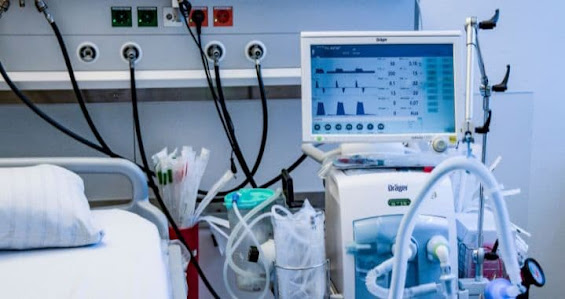VENTILATOR
What ventilators do and their role in COVID-19:
There are different types of ventilator, and each provides varying levels of support. The type a doctor uses will depend on a person’s condition.
Ventilators play an important role in saving lives, in both hospitals and ambulances. People who require long-term ventilation can also use them at home.
People require ventilation if they are experiencing respiratory failure. When this occurs, a person cannot get enough oxygen and may not be able to expel carbon dioxide very well either. It can be a life threatening condition.
There are many injuries and conditions that can cause respiratory failure, include
- head injury
- stroke
- lung disease
- spinal cord injury
- acute respiratory distress syndrome (ARDS)
- pneumonia .
Some people with COVID-19 have severe difficulty breathing, or develop ARDS. However, this only occursin people who become critically ill, which accounts for around 5% of all confirmed COVID-19 cases.
There are several ways a person can receive ventilator support. These include:
- face mask ventilators
- mechanical ventilators
- manual resuscitator bags
- tracheostomy ventilators.
Face mask ventilator:
A face mask ventilator is a noninvasive method of supporting a person’s breathing and oxygen levels. To use one, a person wears a mask that fits over the nose and mouth while air blows into their airways and lungs.
People with COVID-19 may use a face mask ventilator if they are having difficulty breathing or do not have sufficient oxygen levels.
Continuous positive airway pressure (CPAP) and bi-level positive air pressure (BiPAP) devices also operate via a face mask.
Mechanical ventilator:
Mechanical ventilators are machines that take over the breathing process entirely. Doctors use these when a person cannot breathe on their own.
Mechanical ventilators work via a tube in a person’s throat, pumping air into the lungs and transporting carbon dioxide away.
A ventilator unit regulates the pressure, humidity, volume, and temperature of the air, depending on the controls that a doctor or respiratory therapist places. This allows healthcare professionals to control a person’s breathing and oxygen levels.
People with COVID-19 may need a mechanical ventilator if they are critically ill.
Manual resuscitator bags:
Manual resuscitator bags are pieces of equipment that allow people to control the airflow of their ventilator with their hands. These devices consist of an empty bag, or “bladder,” that a person squeezes to pump air into the lungs.
A person can attach one of these devices to a face mask ventilator, or, if they are intubated, a doctor can attach one to the tube in their throat.
This can be useful as a temporary solution if a person on a mechanical ventilator needs to stop using it. For example, if there is a power outage, a person can use a manual resuscitator bag while waiting for the power to come back on.
Tracheostomy ventilator:
People who have undergone a tracheostomy will require a ventilator.
A tracheostomy is a procedure where a doctor creates an opening in the windpipe and inserts a tube, which allows air to flow in and out. This enables a person to breathe without using their nose or mouth.
People who have undergone tracheostomies can also receive ventilator support through this opening. Instead of inserting a ventilator through the mouth, doctors insert it directly into the windpipe.
As with many medical procedures, ventilation involves some risks, particularly mechanical ventilation. The longer a person requires mechanical ventilation, the higher the risks.
Potential complications of using a ventilator include
- atelectasis, which occurs when the lungs do not expand fully, reducing the amount of oxygen that enters the bloodstream.
- aspiration, or breathing objects or fluids, such as saliva, into the airways.
When a person seems ready to come off a mechanical ventilator, doctors first have to ensure the person can breathe independently. They do this via weaning, which involves gradually removing ventilator support.
Ventilators are devices that support a person’s breathing if they are experiencing respiratory failure.
There are different types of ventilator, including noninvasive and invasive, that provide varying degrees of support. Demand for ventilators has increased due to COVID-19.
It can take time to recover from being on a ventilator. Serious illness can impact physical and mental health . People experiencing persistent symptoms after weaning off ventilator support should seek guidance from a doctor.
HAPPY READING!!!






Good 👍
ReplyDelete🌚👀
ReplyDeleteSuper
ReplyDeleteNice bro
ReplyDelete